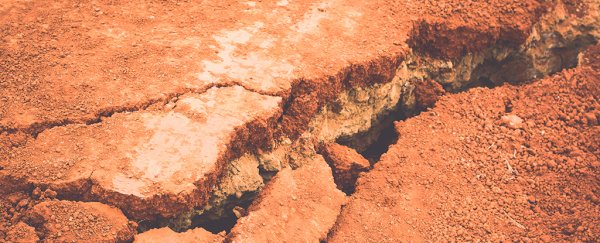We know so much about earthquakes - such as where they're likely to hit and the forces that create them - but figuring out when they're actually going to occur still involves a lot of guesswork. And now a new warning from California State University geophysicist, Julian Lozos, says a 'double-fault' quake could have a devastating impact on southern California.
Lozos' prediction is based on dynamic rupture modelling techniques and historic damage reports that suggest a similar double earthquake has occurred in California's past. Reports show that in December 1812, an earthquake was triggered by a rupture along the San Jacinto fault, but Lozos says the data show signs of energy being transfered from that earthquake to the nearby San Andreas fault, causing it to rupture as well.
To those on the ground, it would have probably felt like one earthquake, even though two fault lines were involved, he says.
According to Lozos's proposed scenario, the earthquake of 1812 started along the 498-km (310-mile) San Jacinto fault before spreading to the 1,303-km (810-mile) San Andreas fault. The resulting earthquake registered 7.5 on the Richter scale and 40 lives were lost in the resulting destruction.
Lozos says this is why seismologists should be paying much more attention to activity on the San Jacinto line. These kind of connected fault lines, where one earthquake can trigger another, have been discussed in the past, where California is concerned.
Of course, with two cracks in Earth's crust to contend with rather than one, there's double the uncertainty about what might happen. But there's the possibility of having a much stronger and more widespread quake to deal with.
Not all seismologists agree with Lozos's predictions, and some believe that multi-fault quakes have already been happening in California for several millennia. But the hypothesis, which has been published in the journal Science Advances, might be enough to convince west coast seismologists to update their prediction models.
As we've already noted, no one can be sure of the final effects: multi-fault earthquakes aren't always stronger than other ones, though they can 'jump' across densely populated areas and cause more damage in that way.
"Combination earthquakes aren't necessarily more powerful than single-fault ones, but they do travel in different ways," Jesse Emspak reports for Smithsonian. "Instead of zipping relatively neatly along the fault line under San Bernardino, a multi-fault earthquake - even a less powerful one than the 1812 temblor - could jump right across a very densely populated region, causing even more damage than anything the San Andreas could produce alone."
"This precedent carries the implications that similar joint ruptures are possible in the future, and that the San Jacinto fault plays a more significant role in seismic hazard in southern California than previously considered," concludes Lozos in his report.
The more that experts can ascertain about the potential for earthquakes in California, the better prepared the state is going to be for the next one.
